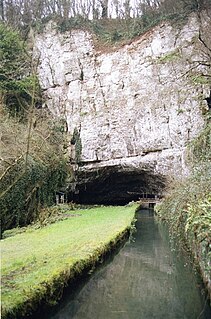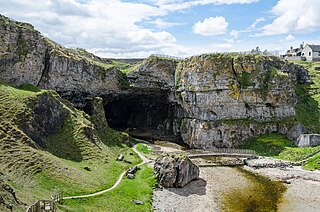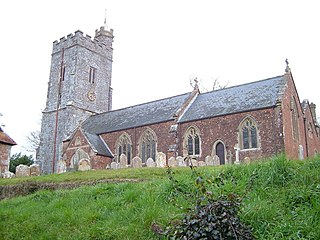
Wookey Hole Caves are a series of limestone caverns, a show cave and tourist attraction in the village of Wookey Hole on the southern edge of the Mendip Hills near Wells in Somerset, England. The River Axe flows through the cave. It is a Site of Special Scientific Interest (SSSI) for both biological and geological reasons. Wookey Hole cave is a "solutional cave", one that is formed by a process of weathering in which the natural acid in groundwater dissolves the rocks. Some water originates as rain that flows into streams on impervious rocks on the plateau before sinking at the limestone boundary into cave systems such as Swildon's Hole, Eastwater Cavern and St Cuthbert's Swallet; the rest is rain that percolates directly through the limestone. The temperature in the caves is a constant 11 °C (52 °F).

Mammoth Cave National Park is an American national park in west-central Kentucky, encompassing portions of Mammoth Cave, the longest cave system known in the world.

Cheddar Gorge is a limestone gorge in the Mendip Hills, near the village of Cheddar, Somerset, England. The gorge is the site of the Cheddar show caves, where Britain's oldest complete human skeleton, Cheddar Man, estimated to be 9,000 years old, was found in 1903. Older remains from the Upper Late Palaeolithic era have been found. The caves, produced by the activity of an underground river, contain stalactites and stalagmites. The gorge is part of a Site of Special Scientific Interest called Cheddar Complex.

Durdle Door is a natural limestone arch on the Jurassic Coast near Lulworth in Dorset, England. Although privately owned by the Lulworth Estate, it is open to the public.

Buckland Dinham is a small village near Frome in Somerset, England. The village has a population of 381. The village's main industry is farming, but the village is also a dormitory village for the nearby cities of Bath and Bristol.

Smoo Cave is a large combined sea cave and freshwater cave in Durness in Sutherland, Highland, Scotland. The cave name is thought to originate from the Norse 'smjugg' or 'smuga', meaning a hole or hiding-place.

Somerset is a rural county in the southwest of England, covering 4,171 square kilometres (1,610 sq mi). It is bounded on the north-west by the Bristol Channel, on the north by Bristol and Gloucestershire, on the north-east by Wiltshire, on the south-east by Dorset, and on the south west and west by Devon. It has broad central plains with several ranges of low hills. The landscape divides into four main geological sections from the Silurian through the Devonian and Carboniferous to the Permian which influence the landscape, together with water-related features.

Chudleigh is an ancient wool town located within the Teignbridge District Council area of Devon, England between Newton Abbot and Exeter. The electoral ward with the same name had a population of 6,125 at the 2011 census.

The Stoney Littleton Long Barrow is a Neolithic chambered tomb with multiple burial chambers, located near the village of Wellow in the English county of Somerset. It is an example of the Cotswold-Severn Group and was scheduled as an ancient monument in 1882. It was one of the initial monuments included when the Ancient Monuments Protection Act 1882 became law.

Biševo is an island in the Adriatic Sea in Croatia. It is situated in the middle of the Dalmatian archipelago, five kilometers southwest of the Island of Vis. Its area is 5.8 km2 (2.2 sq mi) and it has a population of 15.

Odin Mine is a disused lead mine in the Peak District National Park, situated at grid reference SK133835. It lies on a site of 25 hectares near the village of Castleton, England. It is the oldest documented mine in Derbyshire and is thought to be one of the oldest lead mines in England. The mine is a Scheduled Ancient Monument and has biological and geological significance within the Castleton Site of Special Scientific Interest.

Reyfad is a townland in County Fermanagh, Northern Ireland. It lies in the land division of Old Barr, in the civil parish of Boho. The townland has previously been called Rayfadd - 1659, Raffada (Magheryboy) - 1672 and Ráith Fada "long fort" - 1833.
The Caves of the Tullybrack and Belmore hills are a collection of caves in southwest County Fermanagh, Northern Ireland. The region is also described as the West Fermanagh Scarplands by environmental agencies and shares many similar karst features with the nearby Marble Arch Caves Global Geopark.
Devon contains some limestone areas mainly on the eastern side of Dartmoor. The River Dart has created several caves along its fringes. There are few caves with active streamways in Devon, excluding the Bakers Pit streamway. Devon also has its own species of cave shrimp.
Chudleigh Cavern is a limestone cave outside the town of Chudleigh in Devon, England. The cave is deep and contains stalactites. A small part is open to the public as a show cave. The rest is open only to experienced cavers.

Rockbeare is a village and civil parish in the East Devon district of the county of Devon, England, located near Exeter Airport and the city of Exeter. "Whilst the name has nothing to do with either 'rocks' nor 'bears', it simply means 'rooks in the grove '." "The parish comprises the hamlets of Marsh Green, Pithead, Allercombe, and Little Silver". The village, which is of small extent, is situated on the high road from Honiton to Exeter, and is an agricultural town. The land is nearly evenly divided between arable and pasture, with about 200 acres of common. According to the 2011 Census there were 431 males and 483 females living in the parish. "Rockbeare is written within the Broadclyst ward and electoral division, which is in the constituency of East Devon County Council".

The Manor of Ashton was a historic manor in Devonshire, England, of which the manor house was called Ashton House, in the parish of Ashton, situated about 6 miles south-west of Exeter, on the western slopes of the Haldon Hills. It was long the seat of the Chudleigh family, from about 1320 to 1745, which originated at the manor of Chudleigh, 3 miles south of Ashton, and for which was created the Chudleigh baronetcy in 1622. It was abandoned by Sir George Chudleigh, 4th Baronet who in 1735 built himself nearby a grand mansion named Haldon House, on the east side of the Haldon Hills, influenced by Buckingham House in London, and moved his residence there.

Ash Hole Cavern is a limestone cave system in Brixham, Devon, England. There is evidence of human habitation since Neolithic times, and archaeological excavations have been conducted, with several artefacts found. It has been a scheduled monument since 1966.

Kitley Show Cave is a solution cave in Yealmpton, Devon, England. Originally discovered by quarrying, it used to be open to the public as a show cave, but is now closed.

Pixie's Hole is a limestone cave system which is situated on the south side of the Chudleigh Rock, close to the village of Chudleigh, Devon, England. It is listed as a Scheduled Monument by Historic England and was first listed in 1992.



















